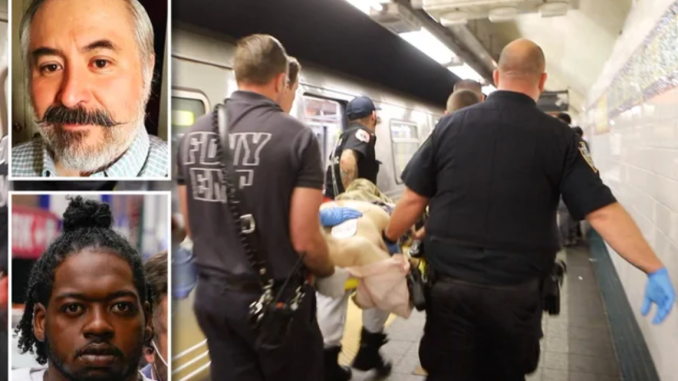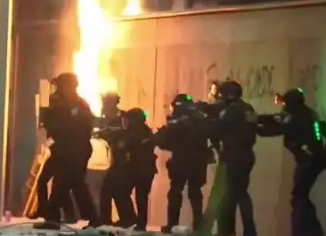
On Sunday, Daniel Enriquez became the New York City subway’s latest “random” crime victim, shot in the chest at close range and killed as he traveled from Brooklyn to Manhattan for midmorning brunch. Enriquez was the fourth person to die by violence on the subway this year, and the third to be killed by a stranger. Each of the four subway killings has something in common with the others: justified intervention by police, prosecution, or incarceration could have prevented it. A few years ago, it likely would have. New York is suffering soaring crime because it has abruptly switched its justice system from enlightened prevention to gruesome mop-up.
The city’s justice system is still good at solving the most serious crimes. Just hours after Enriquez’s murder, police identified a suspect: 25-year-old Andrew Abdullah. But Abdullah’s background points up the fact that there shouldn’t have been a serious crime to solve in the first place. He has a criminal history that stretches back to his teen years. He has 19 arrests and served a state sentence for a previous gun crime. Just six months after winning parole on that conviction, Abdullah was quickly busted again in January 2020 for carrying a loaded gun. His two most recent outstanding cases are for domestic violence and possession of a stolen vehicle. In the car-theft case, just last month, a Brooklyn judge, following guidelines set by New York State’s bail “reform” law, released him without bail.
Like many offenders who ratchet up their lower-level violence to homicide, Abdullah, who has now been apprehended, isn’t the kind of criminal who just made a mistake in the heat of passion and deserves a second chance. When he was 16, he allegedly accosted and sexually assaulted three women in Central Park, all strangers to him, within moments. But New York State’s criminal justice system allowed this antisocial behavior to escalate until, allegedly, he killed Daniel Enriquez on the train.
Abdullah’s criminal trajectory resembles that of Martial Simon, the 61-year-old mentally ill homeless man who shoved Michelle Go to her death from a Times Square subway platform in January. Simon, too, had a long criminal history, serving a state prison sentence for robbery. He was well-known to state and local mental-health officials, even predicting to a hospital psychiatrist a half-decade ago that he would someday push a woman to her death. Yet he, too, was free to escalate his behavior until his prediction came to pass.
The first two subway killings rounding out New York’s grim 2022 quartet (so far) were also preventable. Early New Year’s Day, three teens allegedly surrounded a fellow passenger at the Fordham Road subway station, menacing him until he fell onto the tracks. A bystander, 36-year-old Roland Hueston, tried to intervene, and was killed by a train. The three teens had entered the subway system without paying their fare, going through the exit gate, as most criminals do. An assertive police presence at the train station would have stopped them from doing so.
Bronx security guard Roland Hueston has been described as “an angel” for saving the life of Noel Soto, who was thrown onto subway tracks by a trio of alleged gang members. Soto survived; Hueston was hit and killed by a train.
Similarly, 24-year-old Marcus Bethea, shot and killed, possibly by an acquaintance, at the Jamaica Center subway station in Queens last month, was a known “subway swiper”—someone who procures an unlimited-ride MetroCard and then uses it illegally to sell passengers cut-price entrances to the transit system, often after disabling MetroCard machines so that passengers can’t buy a legal fare. It’s not clear whether Bethea was killed over his subway swiping, but such business is fraught with territorial disputes as well as arguments with passengers who resist handing over cash to a stranger. One of 2016’s two homicide victims was also a subway swiper. If police had kept Bethea and others from illegally loitering at Jamaica Center, they could have prevented his murder.
Better policing and prosecution practices may not have prevented all of these murders, of course. Police can’t be everywhere, and prosecutors and judges have always made mistakes. But statistics show that better practices would have prevented some of them. Since March 2020, 18 New Yorkers have been murdered on the subways. You have to go back more than a decade, from 2009 to 2019, to find 18 New Yorkers who lost their lives to homicide on the subways. New York’s post-COVID transit-crime crisis was apparent as early as April 2020, but by now, even people who ignored and denied it can no longer pretend that the ongoing surge in homicides and other violent crime underground is a statistical aberration.
Marcus Bethea, a 24 year-old “subway swiper,” was shot and killed at the Jamaica Center subway station in Queens last month. “Swipers” buy unlimited MetroCards and then illegally sell rides at discounted prices.
Police are stepping up their enforcement of minor laws underground. In April, they gave out more than 10,000 non-arrest summonses, up a third from April 2019. But this welcome return to Broken Windows policing, spearheaded by Mayor Adams, is being short-circuited by the rest of the state-supervised justice system. Without the eventual threat of arrest for unanswered summonses, these citations for fare evasion and other subway rule-breaking are just worthless pieces of paper.
Only half of people pay their fare-evasion fines. Actual arrests in the transit system, by contrast, are still way down: April 2022 saw 689 arrests, a third below the April 2019 level of 993. Police have made several high-quality arrests in recent weeks, but even when they arrest someone for a serious crime short of homicide, the suspect ends up back on the streets. In mid-May, for instance, police stopped 22-year-old James Williams in a Brooklyn subway for fare evasion and allegedly found him with a loaded gun, but a judge let him go.
This week, the Metropolitan Transportation Authority reported that 12.5% of subway riders — hundreds of thousands of passengers daily — are failing to pay for fares, up from 3.9% before the pandemic.
And after two years of lawlessness, it’s not clear that a return merely to 2019 levels of policing would suffice. In 1990, when the subway system suffered 26 murders, new transit-police chief Bill Bratton had to launch a historic zero-tolerance push against low-level infractions, simply to get people accustomed to obeying the rules after years of laxity. As the state-run Metropolitan Transportation Authority reported this week, 12.5% of subway riders are now beating the fare, up from 3.9% before COVID-19.
Jumping over the turnstile or walking through the exit gate is now just normal behavior for hundreds of thousands of people daily. To get back to normal, or anywhere near it, we likely need 1990 levels of policing, not 2019 levels. Absent the threat of arrest, newly habitual fare evaders won’t be deterred by a civil summons that they don’t have to pay. Nobody is saying that a first-time subway-fare thief should go to jail, but, in the delicate dance of successful preventative policing, a would-be subway-fare thief should think that he might face jail, and recidivist fare evaders — who make up a disproportionate share of the subway’s antisocial denizens — must face eventual arrest.
Last month, 98 violent felonies took place on the subways, up from 66 in April 2019, despite ridership being just 60% of the pre-COVID normal. “It keeps happening and nobody does anything,” Enriquez’s domestic partner, Adam Pollack, told The Post this week. “Nothing will change.” Not yet, anyway.
* Article from: The New York Post


